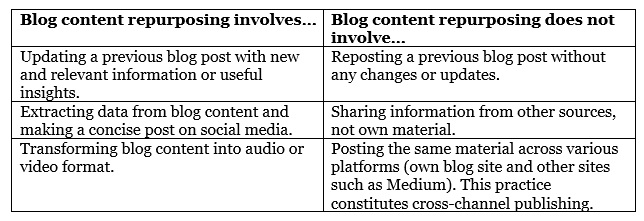
Repurposing Blog Content: 10 Creative Ways to Get the Most Out of Your Existing Blog Content
REPURPOSING BLOG CONTENT: 10 CREATIVE WAYS TO GET THE MOST OUT OF YOUR EXISTING BLOG CONTENT
Producing new content consistently can prove challenging. Tight schedules, personal issues, and unexpected situations can all make it complex to deliver content regularly.
But what if there was a way to maintain a steady stream of content without reinventing the wheel?
Enter repurposing blog content.
In this article we will discuss 10 creative ways content creators can repurpose blog material to continue engaging their audience.
What Is Repurposing Blog Content?
Content repurposing involves taking existing content and utilizing all or part of it to create new content, often in a different format or content delivery platform such as social or even legacy media.
Please note that content repurposing is not the same as content recycling.

With content recycling, content creators take existing content and reissue it in other media.
For instance, a content creator may take blog posts from a personal site and re-publish them on another platform such as Medium. In this example, there is not any new content creation.
It is merely re-locating existing material.
In content repurposing, existing material morphs into something new. For example, an excerpt from a blog post becomes a Tweet. Or, a content creator may adapt a full-length blog post into a YouTube video presentation.
Here is a breakdown of what is and what is not blog content repurposing.

There are many ways in which existing blog content can transition into other media and purposes. The main issue to keep in mind is that current blog content serves as a springboard to new opportunities, thereby keeping content fresh and interesting.
Advantages of Repurposing Blog Content
The biggest advantage of repurposing blogs is maintaining a steady stream of content. Indeed, using existing content can provide creators with a springboard for bigger and better ideas. However, there are five other key advantages content creators cannot overlook.
1. Smoothing Transition to Other Media
There is a point in which bloggers may choose to branch out into other media such as video, podcasts, or livestreaming.
However, they may be unsure about how to transition into new media without losing their original focus.
Repurposing blog content can provide a smooth transition into other media.
For instance, a blogger looking to start a podcast can reuse existing blog content to come up with ideas and information for podcast topics.

Utilizing existing blog content can provide a seamless transition from one media type to another, especially without losing the content’s main focus.
2. Bolstering an Author’s Reputation.
Being a regular blogger can lead to becoming a published author. This approach can help further establish an author’s reputation beyond the “blogosphere.” For instance, established blog content creators may seek to enter the mainstream publishing field. They may, however, need to find material to build a full-length book. Previous blog posts can become the springboard to a book idea. Additionally, repurposed content, particularly when it remains valuable over time, can help strengthen an author’s expertise.
3. Engaging the Audience
There are times when content stalls. When ideas dry up or time to plan new content becomes tight, this situation can happen.

When this occurs, repurposing blog content can help spruce up audience engagement.
Adding new ideas and updated information can turn a stale blog into something more current and appealing.
Please remember that merely reissuing old content may not have the same effect as reworking content to pique the audience’s interests.
Repurposing blog content can become a great way to maintain a consistent flow of engaging content. Therefore, blog content repurposing is a practice all content creators must consider, especially when finding new content ideas becomes challenging.
4. Saving Time and Effort
Posting regular blog content requires planning, writing, and editing. As a result, this process requires time and effort. By repurposing blog content, creators can save time and effort. Repurposed content has already been through the publishing process. It is, therefore, much easier to adapt material into different formats.
5. SEO Optimization
User trends change over time. Consequently, previous blog content may lose relevance due to changing trends.
Repurposing blog content can help improve search engine optimization (SEO) by revamping the material to include trending keywords.

This strategy allows blog content to continue generating visibility and attracting new users.
Creative Ideas for Blog Content Repurposing
There are various ways in which content creators can repurpose their existing blog content. Here are just 10 of the most creative ways we have found.
1. Repurposing Blog Posts into Video Content
Repurposing blog content into video content is a great way of giving older blog posts new life. However, it is worth noting that transforming blog posts into videos does not mean reading and recording previous posts.
Using previous blog content is about taking ideas, points, data, or insights and building fresh content around those ideas. For instance, a previous blog post focused on a specific government policy. Repurposing this content into a video would mean taking the insights from the post and contrasting the policy’s effect. This approach helps build on existing content while delivering new material to audiences.
2. Using Blog Content to Create a SlideShare Presentation
Transforming old blog posts into a SlideShare presentation can be a great way of reviving high-performing content.

In particular, popular blog content can make another successful go-around by morphing into a SlideShare.
This approach gives audiences the opportunity to digest the material in an entirely new way. Moreover, SlideShare enables users to share content, thereby generating additional visibility for the original blog content.
3. Transforming Data-heavy Blog Posts into Infographics
Data-intensive blog posts filled with figures, numbers, and dates can easily shift into an infographic. This approach makes it easy for audiences to appreciate visually the information contained in the blog post. Furthermore, infographics can easily become part of social media posts or part of video content. Infographics can also serve to summarize previous posts and segue into new blog content.
4. Publishing an eBook
Older blog posts that have done their rounds can become effective marketing tools in an eBook form.
However, it is important to avoid cramming blog posts into a bundle. This approach is more akin to an anthology.
While that strategy may generate some visibility, it is not content repurposing.
Blog content repurposing involves taking older blog posts and reworking them so they can transition into a coherent narrative that expands on the blog.

As such, the blog serves as the springboard that compels followers to read the full-length book.
5. Extracting Relevant Quotes
Blog content is often full of useful and relevant quotes. These quotes can then become the subject of Tweets, Facebook, or LinkedIn posts. Utilizing relevant quotes helps establish authors as thought leaders. Thus, the quotes compel readers to check out the original blog content. Please remember that good quotes are a great way of reviving blog content, especially when interest begins to wane. Quotes can further drive discussion on a topic, thereby allowing authors to establish their reputation as subject matter experts.
6. Building a Podcast Episode
Bloggers looking to venture into podcasting can use their existing blog content to build episodes. Blog content facilitates discussion and links original blog content into an entirely different medium. Furthermore, using blog content for podcast episodes allows content creators to expand on other topics and areas not explored in the original content.
7. Morphing Blog Content into Webinars
Educational and informative blog content can serve as a foundation to produce webinars.

Often, blog content is relatively limited in the scope of information it can provide. A webinar, or series of webinars, allows content creators to provide more in-depth materials.
Please note that blog content can act as a hook into a webinar, thereby becoming a marketing tool.
For instance, the blog content is free, but access to the webinar series is part of a subscription service. Webinars can also become part of a sales and marketing campaign. In this regard, repurposed blog content fulfills a key marketing role.
8. Building Courses, Workshops, and Classes
Blog content can lead online or in-person courses, workshops, or classes like webinars. For instance, a series of blog posts can expand into an online or in-person course that offers a hands-on and in-depth approach. For instance, a financial literacy blog may offer general guidelines on budgeting. However, the full course offers coaching on how to effectively budget and save money.
9. Producing Marketing Materials
Previous blog content may have useful information about a product or service. This information can then become the source for marketing materials such as instruction manuals, product guides, tutorials, or brochures. This strategy allows content creators to repurpose blog posts by condensing them into precise bits of marketing copy. In doing so, content creators can save time and money on research and sourcing ideas.
10. Designing Marketing Campaigns
Blog content can also serve as a tool in designing marketing campaigns. For instance, a company blog can become the main focus of a new marketing campaign.
As such, existing blog content morphs into marketing copy, product brochures, video content, tutorials, and sales presentations.

While the blog itself does not become the center of marketing campaigns, its content becomes the source material for the other elements in the campaign.
Final Considerations
Not all blog content is useful for repurposing.
Repurposing content for the sake of it may be counterproductive. Thus, the formats blog content can transition into should be considered carefully.
Assuming that all blog content can effectively transition into video is misleading. Repurposing blog content depends on the strategy in mind. From there, content creators can curate the blog content that is useful for their specific purposes.
Ultimately, the best approach is to ensure that repurposed blog content remains useful and relevant as it transitions into new formats.
That said, repurposing blog content can provide content creators with valuable information sources. After all, tried and true material will likely continue to generate interest among existing and new audiences.
However, content creators must ensure they have a clear strategy in place. Otherwise, repurposing blog content may ultimately be counterproductive.
In general, content creators must keep the following points in mind:
- What is the main objective of repurposing blog content?
- Does the repurposed blog content continue to offer value?
- Does repurposing blog content contribute to an overarching strategy?
- Is repurposed blog content the most effective strategy?
- Would it be more useful to create brand-new content?
The last question is the true Litmus test. In the end, would it be more useful to create brand-new content? If so, content creators must decide if repurposing blog content contributes to their overall goals.

Please bear in mind that repurposing blog content is like remixing a hit song. The right beat can give an old hit new life. In contrast, choosing the wrong beat can destroy a song’s appeal.
Similarly, repurposing blog content is about finding an appropriate format.
Assuming that all blog content is suitable for a single format may take away from its potential. Therefore, content creators must keep an open mind.
Previous blog content can open the door to several different content formats. From video to full-length books, repurposed blog content can become the gateway to bigger and better opportunities.
Related Content
- 0 Comment
Subscribe to Newsletter
- Elevate Your Content: How To Use Canva for Eye-Catching Visuals
- These Tools Are Your Key to the Content Campaign Kingdom
- Strategic Content Marketing: Distribution Methods for Maximum Reach
- The Abilities and Limitations of AI in Content Creation
- How to Use AI to Power Up Your Marketing Communication Strategy


